
ROULETTE STRATEGIES
(Eunice: I like to play. That’s it for me, just playing the game. I will spread my bets all over the layout, bet numbers and propositions. Bet different amounts on different bets based on feelings I get inside me. I don’t have a preset plan, I just go with the flow and the flow is just how I feel at the moment. That is my strategy. That’s how I play roulette if you don’t mind.)

MARTINGALE STRATEGY
The most popular roulette strategy, beautifully articulated by Eunice above, is the YANS, otherwise known as the You-Are-Nuts-System. It is characterized by throwing hard-earned money all over the layout, making almost every conceivable bet, not knowing that the more bets you make the more the house edge is grinding away at your bankroll.
The players who make YANS are also called Yans and, as far as I can tell, they eat a lot of garlic and other spicy food so you don’t really want them next to you or even at your table.
Every bet you make is a separate game with the house. If you are betting 12 and the player next to you is betting 13 that is two games against the house. If you are betting 12 and 13 that is also two games against the house.
Yans using the YANS will probably have little or no understanding of the odds and percentages of the game – and they don’t care to learn such things either “if you don’t mind.”
I would have to say a significant number of roulette players probably use this method or some version of it, and their results are relatively predictable – they get hammered unless they hit an amazing streak of good fortune on very rare occasions.
I think some of these players might be distant relations of those aristocrats of long ago who played and played and played until they became peasants.
There are no words to tone down players of this type except to say to them, “You are crazy to play that way,” and leave it at that “if you don’t mind.”
![]()
WHAT IS THE MARTINGALE ROULETTE STRATEGY
This is the most famous gambling strategy in the world – and I invented it. Well, actually I invented it along with millions of other gamblers throughout the ages. It seems to be human instinct when one begins his or her gambling career to find yourself thinking of using this system without even knowing the system has a long established history and name.
Before I explain the wonders of this system I invented, first let me give you some historical background.
![]()
THE ORIGIN OF THE MARTINGALE STRATEGY
Admittedly, there is some dispute as to where the name Martingale originated. Some gaming gurus believe the name originated with Henry Martindale (note the “d”), a London casino owner in the 1700’s but it slowly changed its pronunciation to Martingale (note the “g”) because some poor sod transcribed the word incorrectly.
That sod was fired by his masters and had to go back to manuring the land by hand, “a fate worse than a fate worse than death.” (from the show Blackadder) Some serious scholars trace roulette back even further and associate it with something to do with a horse – as most croupiers probably know.
There are small bodies of researchers (these researchers stand five-foot or under) who trace the name to a fog-shrouded mythical island whose natives were variously known as the Martins or the Gales. They are now extinct having actually played the Martingale for serious sea shells and colored rocks. It killed them.
In fact, no one exactly knows where this system, created by legions of gamblers, actually got its name. No one actually knows when or where this strategy was played for the first time. But those who have played this system a lot have all had the same experience – and that experience wasn’t good. It was worse than a fate worse than death.
I think I’ve held the bait out long enough for you, so here is the Martingale in all its glory:
HOW THE MARTINGALE STRATEGY WORKS
It’s that simple my friends: every time you lose a hand you double your bet!
Yes, I am guessing that many of you reading this now know that you too created the Martingale system, probably early in in your gambling career, and you played it until the fateful session when it didn’t work and you got destroyed. Welcome to the club of which – you will later learn – I am CEO.
So let us take a 10 unit bet with a house maximum bet of 100 units, 200 units or 400 units. You are going to bet only the “even-money” bets for this example. So if your first bet is 10 units and you lose, your next bet must be 20 units. If you win that bet you are now ahead 10 units. If you lose that bet you go up to 40 units. Every time you win, you are ahead your 10 units and you start all over again.
Sometimes some huge amounts of money will be wagered to win those measly 10 units.
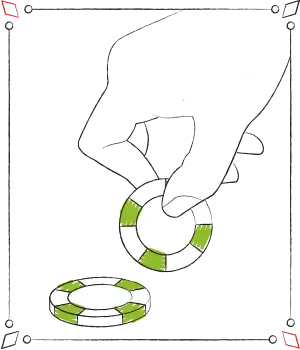
![]()
THE GOOD AND BAD NEWS ABOUT THE MARTINGALE STRATEGY
Here is the good news. You will win an overwhelming majority of your sessions, over 80-90 percent in many cases (depending on the casino’s maximum bet). Yippee! Still here’s what happens as you double up and things don’t go your way in your pursuit of a 10 unit win.
These are the bets you make with 100, 200 and 400 units as the house limit:
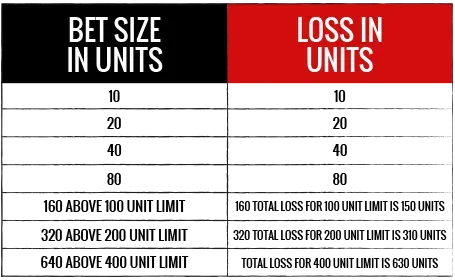
You can see that moderate bad streaks of 4, 5 and 6 losses in a row can cream a Martingale player. Even in most casinos where you can go 7, 8 and 9 losses in a row, the Martingale at some point or other is going to fail you and nail you.
![]()
KEY ELEMENTS
- The YANS of betting has the player just throwing money out without care for how much he bets or where he bets it.
- The Martingale is a double-your-bet after you lose system of play.
- The Martingale will win an overwhelming percentage of time but sooner or later the player will face a bad streak that will take him to the table maximum probably losing all the money he won and then some.
![]()

THE MARTINGALE STRATEGY ODDS
So let’s take a look at the odds and probability of streaks. Again we’ll use the “even-money” bets. I want you to keep in mind that we call these bets “even-money” because they pay even money but each of the even-money bets will win 18 times and lose 20 times on an American wheel and win 18 times and lose 19 times on the European wheel. So these wagers are not indicative of a fair game.

If the casino had no limit on a maximum bet and you had all the money in the world, you could probably in your lifetime use the Martingale and always win. Yes, there would be some sad outlier who doubles and doubles and doubles and loses all the money in the world in a sweat-drenched day that no deodorant can cover up – but I am guessing that won’t happen to you should you amass such a fortune.
![]()
THAT DEVASTATING LOSS
In the real world, although the Martingale will win most of the time, the devastating loss could come in the very first sequence or (if you have a little luck) way, way in the future. But I guarantee you that if you play the Martingale regularly you’ll get hit with the big loss sooner or later and chances are it will wipe out all your previous wins.
I played the Martingale one weekend at the now defunct Sands Casino in Atlantic City. I won and won and won. I was the king of the casino! Then on my last day of the trip I took the Martingale all the way to the end (the house limit) and it ended me. I was betting $5 on the initial bet so all my doubling of bets would only (obviously) allow me to win that $5.
I busted out and lost everything. It was a devastating loss but it taught me a valuable lesson; it is more fun to write about the Martingale than to play it.
This strategy which I invented along with millions of other players (and maybe you too), is not worth playing. The tribes of Martin and Gale went extinct for a reason. We should learn from primitive peoples I always say.
The house edges remain the same when you use a Martingale, 2.70 percent on the European wheels and 5.26 percent on the American wheels.
![]()
THE STRAIGHT-UP MARTINGALE
I hesitate to even hint at this system of play but I assume you are an adult and can handle sheer madness. If you’re a kid, shouldn’t you be doing homework or something?
The inside, straight bets are more complicated but, sadly, you wind up in the same place as those who use the Martingale on even-money bets; the house edge eventually gets you.
WATCH THIS AND WEEP:
1. The payout for a winning bet is 35 to 1.
2. You now bet 10 units (in America this would be $10) on a number.
3. The number loses and you now bet 10 units again (you can bet on any number you wish).
4. The number loses and again bet 10 units on a number.
CUTTING TO THE CHASE:
1. You keep betting a number until you win 35 to 1.
2. Now if you hit on the first wager, you have 350 units. You keep doing the 10 units per number. (Doesn’t matter which wager you hit on, if you are ahead, you keep doing the 10 units per number.)
3. If you win on the 35th bet, you now have a push as you bet 35 numbers, won one (350 units) but lost 350 units. You keep betting 10 units until…
“THE HORROR, THE HORROR!”
1. You blow 35 bets (and it will happen). You haven’t won 350 units. You’ve lost 350 units.
2. You can’t recover without a 20 unit bet since this is the 36th decision.
3. Now you bet 20 units per spin.
4. But you can’t go 35 spins betting 20 units because you must make up the loss of the 350 units plus any 20 unit loss that follows.
5. If you lose another 18 spins you are now behind 710 units.

![]()
BEATING YOUR HEAD AGAINST THE MATH WALL
You know where this is going, right? With each increase in the amount you need to bet to win the session, the number of spins decreases. The amount of money markedly increases and the risk increases tremendously. You can get to the point where only a few spins remain before you either bust out or hit the house maximum.
If you are ahead at any point at any time in the game you can quit but most gamblers won’t want to quit until they get their “time” in – whatever that time might mean to an individual. A hit in the early going will probably not satisfy a gambler.
Avoid this style of play. Like all Martingales, it will be a killer when the axe falls. Hard though it is to imagine, the house edge on this method of play is 5.26 percent for the double-zero wheels and 2.70 percent for the single-zero wheel. You can’t escape the house edge or me constantly reminding you of it.

![]()
THE GRAND MARTINGALE
The Martingale is a dangerous betting method. So in order to fix it some players have created the Grand Martingale.
The Grand Martingale makes the Martingale actually look good. Why is that? Because the Grand Martingale loses your money more quickly than does the Martingale; you are no longer doubling your losing bet, you are going even higher. You might bet 10 units, lose it, and your next bet might be 30 units; lose that and then you bet 80 units; then 200 units, then 600 units and then you sell your children.
The winning streaks are fewer since you will hit the house maximum bet far sooner. The players who use the Grand Martingale figure if they double-plus their previous bets, they will win more. In short-term play this might happen but the devastating loss is far closer than most players realize. In fact, it is breathing on the short hairs of their necks.

Skip this method of play unless you want your money to go extinct just like the Martins and the Gales. The house edge on this method of play is 5.26 percent for the double-zero wheels and 2.70 percent for the single-zero wheels. I realize you realize this house edge business by now. Life is full of realizations that are annoying – isn’t it?
![]()
KEY ELEMENTS
- It is inevitable that the longer you play the Martingale the greater your chance of hitting that monstrous losing streak.
- The Straight Up Martingale starts off rather slow but as the bets increase they must increase at a very fast rate. The blow-out on the Straight-Up will happen quickly once the betting levels rise.
- The Grand Martingale adds money to the bet increases. For example, instead of going from $10 to $20 to $40; the Grand Martingale player might go $10 to $30 to $80 which would increase his probability of hitting the house maximum much sooner.

THE LABOUCHERE STRATEGY

(Philippa: I played the cancellation system that I bought from someone who shall remain nameless since he gave me a false name and when I wanted to get my money back he disappeared. It was okay until I got crushed. You have to be very careful how much money you decide to play with because, trust me, you can go overboard which is exactly what I did. I drowned.)
This is the most frequently sold roulette gambling system for the past 100 years. It is guaranteed to win! At least that’s what systems sellers claim as they proposition roulette players looking for a winning strategy.
Roulette players buy the system, lose with the system, curse the seller, wander about the casino bemoaning the fact that their losses are piling up again. It is sad. But it goes on all the time.

![]()
THERE’S SOMETHING ABOUT HENRY
The strategy was discovered by Henry Labouchere, a noted (and some say impoverished) gambler who toured the world wishing and hoping that money would come his way. He died in 1912, the same year the Titanic sank along with many roulette players who used Labouchere’s system. We might want to change the name of the system to “the iceberg.”
What Labouchere actually discovered and appropriated, naming it after himself (he was far from a humble man), was a mathematical system created by the 18th century French mathematician the Marquis de Condorcet who was known for his swordsmanship. Had Condorcet been alive two hundred years later I am guessing he would have lanced Labouchere but good.

![]()
CANCELLATION ON MY MIND
This is a cancellation system and it is fun to play if you keep your head about you. Will it give you an edge? No. Does it change the house edges on the bets? No.
So what the heck does it do? It gives the player a systematic method of play as opposed to just throwing bets out all over the place as the Yans do.
There are numerous variations of this system of play, some using much money, some somewhat more contained. Below is the most common one:
You take a row of numbers; let me use 1, 2, 3, 4, 5.
Each number is a unit of betting. You determine what that unit represents. The first bet adds the first number (1) with the last number (5) which gives you (6). Each time you lose your bet you now add the total of the last bet to your column, thus you now have 1, 2, 3, 4, 5, 6. If you win the next bet (1+6) for 70 units you are ahead 10 units. You now subtract the 1 and the 6. Instead of winning, if you lose that bet, you add a 7 to the end of the number string.
Every time you win a bet, you cancel the first and last numbers, thus giving you 2, 3, 4, 5. Win again and it is 3 and 4. If you lose, you now have 3, 4, and 5 as the sequence. Should you now win that 3 + 5 wager, your next bet would be the 4 and if you win that you will own the casino, or at least be able to buy lunch.
If you cancel all the numbers, you have won for that sequence. You can see clearly that a bad session will hurt you just as the Martingale did. You’ll probably want to keep your betting units low so you can withstand a long losing streak and those streaks will inevitably come.
![]()
THE ECONOMICS OF LABOUCHERE
Here is an economic way to look at the system. Instead of using numbers we use a 10 unit bet. Watch how the losses mount as you go up the ladder in a simple Labouchere:
Sequence: 10, 10, 10, 10, 10
1. Bet: 20 units
Lose: 10, 10, 10, 10, 10, 20
2. Bet: 30 units
Lose: 10, 10, 10, 10, 10, 20, 30
3. Bet: 40 units
Lose: 10, 10, 10, 10, 10, 20, 30, 40
4. Bet: 50 units
Lose: 10, 10, 10, 10, 10, 20, 30, 40, 50
5. Bet: 60 units
Lose: 10, 10, 10, 10, 10, 20, 30, 40, 50, 60
6. Bet: Your most annoying child.
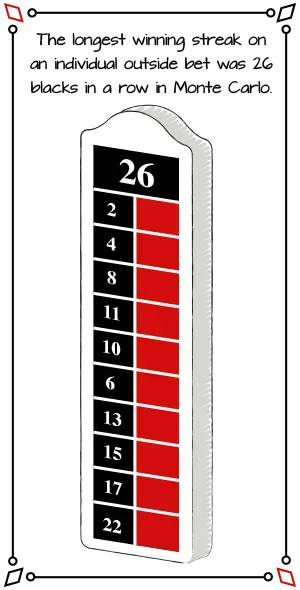
With five losses in a row, you are now betting 70 units (10 units + 60 units = 70 units). The odds of having five losses in a row are 40.82 to 1 on the double-zero wheel and 35.65 to 1 on the single-zero wheel. These are not big numbers and I am sure our roulette players out there have seen even-money bets with streaks far longer than five.
![]()
GOING ALL THE WAY UP
If you wish to take your Labouchere sequence as far as possible (which would be the table limit) you have to bring enough money in order to make those big bets.
At some point you will not be able to continue with the system as you’ve lost your bankroll for the session or you’ve hit table maximum and can’t place another bet.
Many Labouchere players decide in advance how much money they want to win and set up their number system in such a way so as to win that amount should all go according to plan. If I want to win 10 units then I set up my betting as 12322 which adds up to 10 units.
Playing this system is fun but it is not a guaranteed win. How much will you lose?
On the double-zero wheel you will lose 5.26 percent of all the money you’ve wagered and on the single-zero wheel you will lose 2.70 percent of all the money you’ve wagered. You just can’t escape that darn house edge.
![]()
KEY ELEMENTS
- The Labouchere betting system is a cancellation system.
- You have a string of numbers and you bet the combination of the first number and the last number. If you lose you add a number to the top number. If you win you keep the betting the same as previously.
- Much like the Martingale a long string of losses will take the player to the house maximum.
![]()

THE D’ALEMBERT STRATEGY
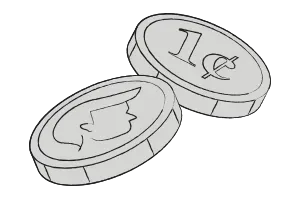
The brilliant French mathematician Jean Le Rond d’Alembert really screwed up on this one. He believed in something he called the “Theory of Equilibrium.” In gambling circles we also call this idea “The Gambler’s Fallacy” or “The Maturity of Chances” or the “That Was a Really Dumb Idea.”
Let us take a coin flip. You have a head and a tail on the coin, each with a 50 percent chance of showing on any given flip (any joker who now says, “Yeah, but what if the coin lands on its side?”
In theory, given enough flips, the coin should land 50 percent of the time on heads and 50 percent of the time on tails. That is probability. Unfortunately, that is probability being right in theory and wrong in gambling practice.
![]()
ISN’T THAT RIGHT?
Let us now say that we are gambling on the coin flip. Should an amazing string of wins by either heads or tails happen then one should switch to the other side because that side has to catch up to make the end result 50/50. Isn’t that right?
In 100 flips of the coin 60 heads show and 40 tails show – it is a 60/40 split. That means heads has to slow down and tails has to hit more often in order for the 50/50 equilibrium to establish itself. Isn’t that right?
After all, 60 heads is 60 percent of the time when it should only be 50 percent. Tails is squeaking in with a miserable 40 percent. It has to hit more to make it to the 50 percent. Isn’t that right?
The answer for the gambler – the incorrect answer – is that tails has a better chance of showing up in the future so bet it. Hey, wait a minute, I thought that was right?
![]()
SORRY BUT YOUR IDEA IS WRONG
That is wrong, totally wrong on all the words “right” used above, and here’s why:
Let us make heads a unit and tails a unit. Now let’s go all the way. Let us have a million flips of the coin; at the end of which the relationship of the flips shows heads with a 50.5 percent hit rate and tails with a 49.5 percent hit rate. Wow! They are catching up; a mere 1 percent separates them where 20 percent separated them at the start.

![]()
A YES AND NO SITUATION
In terms of percentages, they have indeed caught up, but in terms of absolute numbers, heads has hit 505,000 times and tails has hit 495,000 times. The distance between the two is now 10,000 units!
You would have been far better off betting heads all the way even though the percentages seem to be converging. The next million flips could see heads surge ahead or see tails continue to catch up. The chances of either happening are – you guessed it – 50/50.
In a random game such as roulette, if you want to play into The Gambler’s Fallacy that is fine. As long as you do not escalate your bets (a la the Martingale) then you are not harming yourself any more than anyone else betting the exact same amount facing the house edges of 5.26 percent and 2.70 percent. But if you start raising your bets, again a la the Martingale, you are asking for big trouble.
So Jean Le Rond d’Alembert made one mistake in his life. He was not perfect. I made a mistake once too but I divorced it.
![]()
KEY ELEMENTS
- The d’Alembert betting system is also known as the Gambler’s Fallacy. There is a belief among gamblers that if some numbers have appeared more than probability suggests then other numbers will increase to cause equilibrium.
- Gamblers will then bet on the numbers which have not appeared in the mistaken belief that they will come up more often from this point forward.
![]()

THE FIBONACCI BETTING STRATEGY
The Fibonacci strategy is based on an elegant mathematical proof that was first discovered by an Italian mathematician named Fibonacci whose book Liber Abaci discussed this proof for the first time in the West.
But good old “Fib” (as his friends started calling him) wasn’t actually the first to discover this mathematical truth; the sequence had been described earlier in Indian mathematics and poetry. (Who says science and literature don’t mix?)
![]()
THE SEQUENCE SEEMS UNIVERSAL
Evidently the Fibonacci sequence of numbers can be found in all of nature; in musical notes, poetic structures, budding flowers, swaying trees, and you swaying after too many drinks. Gamblers, an irascible lot, decided to create a gambling system using the Fibonacci sequence.
And here it is!
1, 1, 2, 3, 5, 8, 13, 21, 34, 55, 89, 144… (on and on it can go if you let it)
The gambler now uses these numbers to structure his bets. Think of each of these numbers as indicative of how many units you should bet. If you are a 10-unit bettor, the sequence would go like this: 10 units, 10 units, 20 units, 30 units, 50 units, 80 units, 130 units, 210 units, 340 units, 550 units, 890 units, 1440 units.

![]()
THOSE BIG WAGERS ARE INEVITABLE
Yes, if you go all the way up a Fibonacci sequence you are going to have some awfully big wagers.
If you win your first bet (10 units) then you keep betting that amount until you lose. When you lose then you make the second bet which would again be 10 units in the sequence. If you lose that you make the third bet which is 20 units.If you win a bet along the way, you return back down by two numbers. For example, if you win 130 units, you head back down to the 50 unit wager.
Unlike the Martingale, the Fibonacci system will not give you wins along the way – it will reduce your losses and allow you to hang in there in case you get on a winning roll (a craps term that is apt in this case for roulette).

FIBONACCI IS EASY TO UNDERSTAND AND APPLY
The Fibonacci is not too hard to understand. If you win that first bet you just keep betting it until you can buy a yacht.
Okay, do you want to know what the house edge is? No? You sure?
If you play in a casino where the house allows surrender or en prison on even-money bets, your even-money play will be that much better since the house is taking a smaller cut.
Still don’t want to know those house edges?
![]()
KEY ELEMENTS
- The Fibonacci Betting System is based on this number sequence: 1, 1, 2, 3, 5, 8, 13, 21, 34, 55, 89, 144… (on and on it can go if you let it).
- Each number is separated from the other numbers by adding the two previous numbers. Thus, “5” is made with the addition of “2” and “3.”
![]()

THE PAROLI SYSTEM
GIVE ME SOMETHING POSITIVE!
[Jackie: Don’t tell me what to do with losses. I know what to do with them. I go home and fume. Tell me how to make more money as I am winning. That’s what I want to know; how to capitalize on a winning streak.]
You will note that the famous strategy I’ve discussed (except for the YANS) dealt with how to handle losses. Their ideas were similar, an attempt to win a small amount by increasing one’s bet as one kept losing in order to recover the first bet or to just stay within striking range of getting even.
These are also referred to as negative systems as they deal with a negative situation. They aren’t trying to maximize wins; they are trying to diminish losses. A positive system is just the opposite. Here the player wants to increase his winning potential as he finds himself in a winning streak.

![]()

THE PAROLI BETTING STRATEGY
(The Captain: There are no current conditions in a random game. What happened in the past has no bearing on what will happen in the future. You are not on a winning streak; you just experienced a winning streak. It might continue; it might not.)
The most famous positive betting strategy is called the Paroli, named after some guy named Paroli or some Italian card game or, in fact, nobody actually knows and probably no one even cares; although Paroli it might be the pizzeria around the corner from me. Still, people use this system all the time whether they know the name Paroli or not.
![]()
PARLEY VOUS?
Some players call this a “parley” in order not to give Mr. Paroli or the card game or the pizzeria credit for this ingenious system. This could be an “ah-ha” moment for you as you might have parlayed some of your bets in the past.
In its simplest form, you double your bet three times in a winning progression: 10 units, 20 units, 40 units. You’ve won three times in a row, bringing in 70 units. At this point you drop back down to 10 units. So the betting goes 1, 2, 4, and back down to 1.
Take a look of what odds are stacked against a three-step Paroli winning streak on even-money bets at roulette:
![]()
A SMALL PAROLI OR A BIG FAT PAROLI?
You can see how easy it is to play around with the Paroli system. Some cautious players do not like the idea of dumping their win right back out as a bet and they might decide to put half the win and keep the other half.
You could do a two-step Paroli; a one-third step Paroli; a “who-the-heck was Paroli?” Paroli.
More action-oriented players (casinos love these players!) might decide to go for a four-step or five-step Paroli – which means these people are probably in the YANS club.
![]()
THE GAMBLER
The 2014 movie The Gambler has a nutty Paroli gambler played brilliantly by Mark Wahlberg who just keeps doubling his bets as he wins and obviously the last bet he makes is always a loser – no matter when it comes, he’s lost all his money. Our gambler is Paroli-mad. (In the movie The Godfather the line was actually “Don’t forget the Paroli.” Okay, I couldn’t resist that one.)
The house edges remain the same no matter how you bet so…do I really have to do this? Okay, it is 2.70 percent on the single-zero wheels and 5.26 percent on the double-zero wheels.
REPEAT: If you play in a casino where the house allows surrender or en prison on even-money bets, your Paroli play will be that much better since the house is taking a smaller cut when those 0’s and 00’s occur.
![]()
WILD PAROLI SYSTEMS
Just about anyone can come up with versions of the Paroli system. Instead of increasing one’s bet after a win, a player can spread to two outside propositions.
For example, he wins on “black” and then puts that win on “even.” A win on both these propositions will see him then bet “high.” If he loses on any one bet, he goes back down to his original bet and starts the three-bet Paroli all over again.

![]()
KEY ELEMENTS
- The Paroli betting system has come to be known as a parley system.
- You take your win(s) and add all or part of them to your next bet.
- This is a system designed to capitalize on a hot streak.
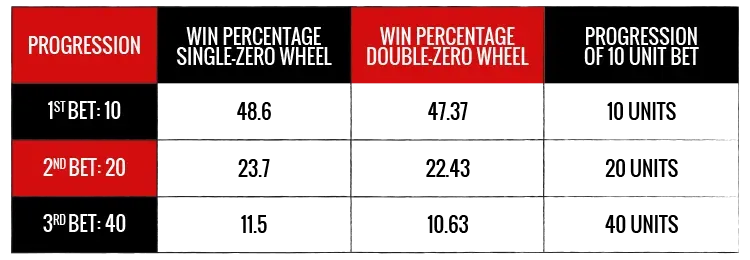

Quiz
1. What is the basic Martingale?
2. What is the major problem with the basic Martingale?
3. What happens with a Martingale on the inside numbers?
4. What is the Grand Martingale?
5. What is the YANS?
6. What is the Labouchere system?
7. What is the Fibonacci system?
8. What is the Paroli system?
9. What is the Gambler’s Fallacy?
10. The negative betting systems attempt to do what?
ANSWERS
1. The basic Martingale is to double up your bet after a loss so that if you bet 10 units, you lose; you then double to 20 units. If you lose the 20 units, you double to 40 and on up it can go.
2. The major problem with the Martingale concerns the fact that at some point you will hit the house limit and lose a lot of money. Betting huge amounts to win that first bet is extremely dangerous.
3. The inside Martingale grows to enormous amounts because you are betting on fewer and fewer spins of the wheel to make up what you lost previously. As with the regular Martingale you will ultimately hit the house limit on betting amounts.
4. The Grand Martingale is the Martingale on steroids. Instead of doubling one’s bet after a loss, the player adds more money to the bet. So it could go 10 units, 30 units, 80 units on up. The house limit can be hit far earlier than on the basic Martingale.
5. The YANS is the “you are nuts system” where the player just keeps throwing money onto the layout with no scheme or plan. Playing this way will usually result in large losses because of poor money management and lack of discipline. So do not be a Yans player!
6. You take a row of numbers; 1, 2, 3, 4, 5 with each number being a unit of betting. The first bet adds the first number (1) with the last number (5) which gives you (6). Each time you lose your bet you now add the total of the last bet to your column, thus you now have 1, 2, 3, 4, 5, 6. If you win the next bet (1+6) for 70 units you are ahead 10 units. You now subtract the 1 and the 6. Instead of winning, if you lose that bet, you add a 7 to the end of the number string. If you cancel all the numbers, you have won for that sequence.
7. The Fibonacci system using the following number sequence to establish one’s betting levels: 1, 1, 2, 3, 5, 8, 13, 21, 34, 55, 89, 144 (etc.). If you are a 10-unit bettor, the sequence would go like this: 10 units, 10 units, 20 units, 30 units, 50 units, 80 units, 130 units, 210 units, 340 units, 550 units, 890 units, 1440 units (on up).
8. The Paroli system is an up as you win system. Usually it is three increases after wins such as 10 units (win), increase to 20 units (win), and increase to 40 units. The player is using his wins on the next round. This system can be changed as the player desires. This is commonly known as the parley system.
9. The Gambler’s Fallacy is also another name for the d’Alembert system. The belief here is that nature evens things out. If there is a 50/50 proposition such as a coin flip and one side takes a commanding lead, the other side must make up for the problem and start to hit more often – evening everything out.
10. A negative betting system attempts to secure a win after many losses by betting more and more. It can end in a disaster when the betting limits of the casino are reached. (Or when the player loses all his money.)
![]()


